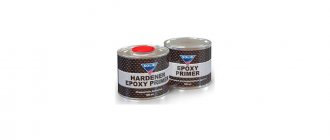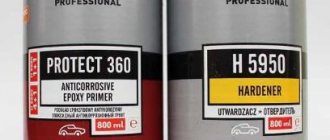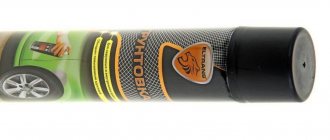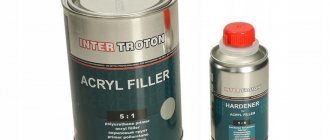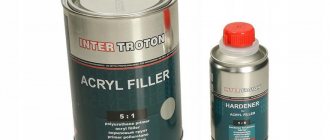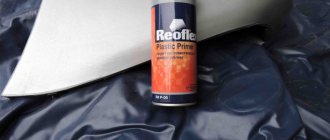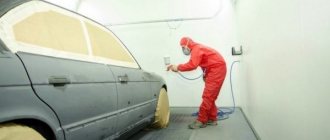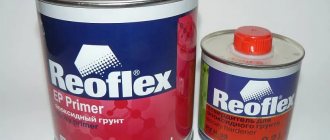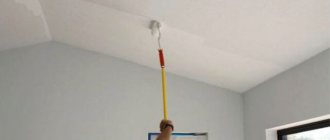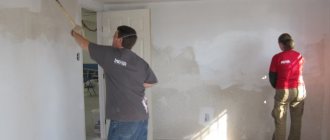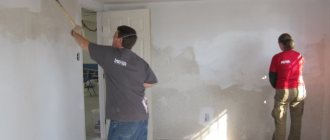What is epoxy primer
Epoxy-based primer belongs to the class of two-component paint coatings designed to protect metal coatings from corrosion. They are produced in metal cans of various capacities or in the form of an aerosol. The last type of substance differs from the canned variety only in the method of application.
Anti-corrosion epoxy primer Ranal EP
Epoxy primer: properties, advantages, disadvantages
Epoxy primer for metal for cars is essentially a multifunctional substance, but the main function is to protect the surface from corrosion and improve adhesion.
In addition, a substance of this type is often used as a thermoplastic insulator. Such qualities are ensured due to the composition - special chemicals and epoxy resins.
Automotive epoxy primer has both advantages and disadvantages. The positive qualities include the following:
- resistance to external mechanical damage;
- does not allow water to pass through;
- provides excellent adhesion;
- plastic and durable;
- heat resistant;
- durable;
- layers lay down evenly and dry quickly;
- environmental friendliness - despite the fact that the composition contains a huge number of chemical elements, the substance does not pose a danger to the environment and human health. But you should still take precautions when working with the substance.
Automotive epoxy primer Reoflex 0.8 l + hardener 0.2 l
There are also negative sides:
- the epoxy base takes a long time to dry - at a temperature of about 20 degrees, complete drying will take at least 12 hours;
- You cannot use high-temperature drying - as bubbles and cracks will form on the surface, which will make further high-quality painting impossible.
Therefore, you can only use epoxy primer for metal if you have time.
Classification
There are quite a few varieties of this substance - each manufacturer produces several subspecies. In general, epoxy primer for metal is divided into two types:
- one-component - such a primer does not contain a hardener, which adds one, but significant disadvantage - it takes too long to dry;
- two- or multi-component - the composition includes high-quality hardeners, so the drying process is much faster - about 12 hours. Moreover, excellent value for money.
The primer is available in metal cans and in aerosol form.
Epoxy primer in a can
Acid soil – special – – catalog of articles – body repair
One of the most frequently asked questions is the question about acidic soils.
Before we begin, let’s determine what components are included in the “acid agent”.
For this conversation, I chose Reoflex acid primer, primarily because I use it myself. It looks like this:
As you have already noticed, the soil consists (usually) of two
components: base and hardener.
The base is a mixture of synthetic resins, anti-corrosion pigments and organic solvents. Hardener – phosphoric acid.
When mixed, a chemical reaction occurs, increasing the temperature of the material. There is nothing wrong with this: the temperature is not so high as to melt plastic dishes.
The primer has a non-uniform yellow color and it is very difficult to cover the material with it in order to obtain an evenly painted surface, and there is no need to strive for this. It is quite enough to apply the primer in one or two layers, without trying to get a surface painted in one color.
Now let's see why it is needed, because many soils also have anti-corrosion properties.
To begin with, I will say that the “acid agent”, due to the presence of acid in its composition, has excellent adhesive properties to such metals as aluminum, stainless steel, galvanized iron - which ordinary acrylic (one or two) component primers cannot boast of.
The following: due to the same acid, the soil applied directly to the “bare” metal enters into a chemical reaction with it and forms a protective film that prevents the access of oxygen and moisture to the metal, which prevents the development of rust. Acid primer is used both to treat old parts, after removing corrosion, and new ones - to prevent its appearance. Keep in mind: acidic soil in itself is not a “fighter” against rust. There are converters for this; it only prevents the appearance of a new one.
The soil cannot be sanded. Before application, the part must be prepared:
remove rust, treat with converter, grind (gradation
sandpaper as for the 2K primer you will use) and degrease.
Acid primer is not used alone; it must be covered with acrylic primer before applying the main paint and varnish material.
PS After reading the comments, I’ll add a little.
Some acid soils have the words “reactive” and “phosphating” in their names, and I see no reason not to use them for all acid soils, since they contain phosphates and are aggressive towards metals.
Indeed, Mobihel has a one-component acid-containing primer.
Scope of use
Painting with epoxy primer is in demand not only when working on a vehicle - this type of substance can be used to coat other large objects, but only metal ones.
Important! The primer for concrete work should not be confused with the one used for metal work. These are completely different products in composition, and the result of the work can be unpredictable, not in the positive sense of the word.
In general, “epoxy” can be used in the following cases:
- on top of “bare” metal - it can be either steel or aluminum;
- over a mixed surface - with putty;
- as a final insulating layer;
- as a means of improving surface resistance to mechanical damage;
- application to fiberglass parts, but only as the first layer.
In any case, before you start treating the surface, you need to carefully read the instructions and make sure that this particular type of primer is suitable for a particular type of surface.
Epoxy primer for metal SG 34
The worst of the worst! reoflex primer (directly on metal)
Due to my lack of experience and on the advice of the seller, I bought REOFLEX (DIRECTLY TO METAL)…
on the same day I started cleaning and smearing, and the process began! )) after some time, about two or three weeks, we dragged the UAZ to weld the box, and as luck would have it, at that moment it began to rain, but not heavily (it only wet the dust).
In general, after another week, rust began to appear on the miracle soil. I started digging in the rain, saying it was no good, but wet)) but then I looked carefully and noticed that the rust was breaking through even where it was dry... In general, it all ended with the fact that I bought BODI primer (phosphalting) and after repeated cleaning, local, everything has been processed!
Surface for epoxy primer
Before processing, you should properly prepare the surface - this way epoxy primer for cars adheres much better. The work algorithm is approximately as follows:
- clean the body from old paintwork and rust using a sandblaster or grinder;
- if necessary, carry out mechanical straightening;
- degrease the surface;
- treat the surface with anti-corrosion agents;
- defects need to be puttied;
- After the putty has dried, sand the surface.
Important: when working with the substance, you must follow safety precautions. The primer must be used strictly according to the manufacturer's instructions. Drafts and dust should not be allowed to form in the room.
CINEP®
PURPOSE
Epoxy primer TsINEP is used to protect against corrosion of metal structures in the atmosphere, including those with high corrosive activity. The coating is resistant to spills of sea and fresh water, aqueous solutions of salts, oil and petroleum products. TsINEP can be used as a primer in complex corrosion protection systems, and as an independent anti-corrosion coating.
CHARACTERISTICS
Primer TsINEP
- Provides tread protection for steel.
Coating
- Has a high service life;
- Resistant to aggressive environments (including spills of sea and fresh water, oil and petroleum products).
AREAS OF APPLICATION
Epoxy primer TsINEP is intended for anti-corrosion protection of transport, industrial and civil construction facilities, and is also used in the chemical industry.
RECOMMENDATIONS FOR THE USE OF CINEP PRIMER
The material is approved and recommended for use by industry specialized testing centers and is included in regulatory documents regulating the activities of various industries.
CERTIFICATION
- Certificate of state registration No. RU.66.01.40.015.E.000146.07.17 dated 07/16/2018
- Certificates of conformity for complex coating systems with fire retardant compositions PLAMKOR-2, PLAMKOR-3.
- Oil and gas complex: Meets the requirements of regulatory documents (for anti-corrosion protection of offshore structures), Rosneft, Lukoil.
- Transport construction: STO-01393674-007-2019 JSC "TsNIIS", STO 12288779-001-2020 GC "Avtodor"; accreditation of JSC Russian Railways, standard technological regulations for anti-corrosion protection of metal spans of new railway bridges 12288779.02073.00160.
- Industrial and civil construction: recommended for use by GOST 9.401-2018, RD GM 02 18 of the Gidromontazh Trust, recommendations of OJSC NIKIMT-Atomstroy for use at nuclear power plants, MMC Norilsk Nickel.
DESCRIPTION OF CINEP PRIMER
CINEP is used as a primer in coating systems with materials based on epoxy, polyurethane, vinyl chloride and copolymer-vinyl chloride bases. The zinc powder contained in the composition provides cathodic protection for the steel. The TsINEP primer has all the advantages characteristic of epoxy-based materials. These include excellent adhesion to metal surfaces, high chemical resistance and mechanical strength. Due to its high performance characteristics, epoxy primer is widely used to protect objects operating in aggressive industrial environments.
SPECIFICATIONS
| Coating | |
| Thickness of one dry layer | 40 – 80 µm |
| Heat resistance | 120 °C |
| Primer | |
| Density | 2.80 - 3.00 g/cm 3 |
| Mass fraction of non-volatile substances | 84,0 — 87,0 % |
| Viscosity | thixotropic |
| Viability at temperature (20±2) ºС, h, not less | 12 |
| Drying time to degree at a temperature of (20±2) °C, hours - to degree 3 according to GOST 19007 - “before turning” | 2 11 |
CONSUMPTION PER M 2
The theoretical consumption for a single-layer coating is 195 - 390 g/m2.
SURFACE PREPARATION
- degrease the metal surface to the first degree according to GOST 9.402;
- perform abrasive blast cleaning of the metal surface to degree 2 according to GOST 9.402 (Sa 2 1/2 or Sa 2 according to ISO 8501-1) with roughening, recommended surface profile Rz from 30 to 50 microns. For hot-rolled steel, mechanized and manual surface cleaning is allowed up to degree 3 according to GOST 9.402 (St 3 or St 2 according to ISO 8501-1). Application on a smooth surface without adding roughness is not allowed;
- remove dust.
INSTRUCTIONS FOR USE OF CINEP PRIMER
- Before use, mix the primer base until smooth;
- add the primer hardener to the base, stirring (mass ratio 5.5:100, respectively); leave for at least 30 minutes before applying;
- Before use, mix thoroughly until smooth;
- If necessary, dilute to working viscosity immediately before application.
Apply in factory and field conditions in 1-2 layers using airless, pneumatic (air) spraying, roller, brush at temperatures from 0 to plus 40 ° C and relative humidity no more than 85%.
Each subsequent layer of TsINEP primer should be applied when the previous one has dried “to touch” (light pressure with a finger does not leave a mark on the coating and does not give a sticky feeling).
The minimum exposure time for the TsINEP coating before applying anti-corrosion coating materials (at a temperature of (20±2) ºС and relative air humidity (65±5)%) is 3 hours, before applying fire retardant compounds - 24 hours; before packaging and shipping of structures - at least 24 hours.
The maximum holding time before applying top coats is no more than 1 year. The exposure time of the coating before use in aggressive environments is at least 7 days.
| Airless spray | |
| Recommended thinner | SOLV-EP (TU 20.30.22-106-12288779-2018), grades 646, 647, 648 |
| Thinner quantity | up to 5% by weight |
| Nozzle diameter | 0.015" - 0.021" (0.38 - 0.53 mm) |
| Pressure | 15 - 25 MPa (150 - 250 bar) |
| Air Spray | |
| Recommended thinner | SOLV-EP (TU 20.30.22-106-12288779-2018), grades 646, 647, 648 |
| Thinner quantity | up to 5% by weight |
| Nozzle diameter | 1.8 - 2.2 mm |
| Pressure | 0.3 - 0.4 MPa (3 - 4 bar) |
| Brush/roller | |
| Recommended thinner | SOLV-EP (TU 20.30.22-106-12288779-2018), grades 646, 647, 648 |
| Solvent quantity | up to 5% by weight |
| Equipment cleaning | SOLV-EP (TU 20.30.22-106-12288779-2018), solvent grades 646, 647, 648 |
STORAGE OF ANTI-CORROSIVE PRIMER
The primer is supplied complete: base packed in metal buckets with a capacity of 10 l and metal cans of 1 l, hardener - in metal buckets with a capacity of 3 l and metal cans with a capacity of 0.25 l, respectively, depending on the weight of the kit.
Storage and transportation of the primer is in accordance with GOST 9980.5-2009 (at ambient temperatures from minus 40 to plus 40 ° C). Containers with primer should not be exposed to precipitation or direct sunlight.
Guaranteed shelf life in a hermetically sealed container from the manufacturer: primer base – 12 months, hardener – 18 months from the date of manufacture.
SECURITY MEASURES
When working with primer, comply with relevant industry regulations and requirements, as well as the precautions indicated on the container label.
It is necessary to use personal protective equipment (goggles, masks, respirators), avoid inhalation of solvents during evaporation and contact of the primer with the skin, mucous membranes of the eyes and respiratory tract; Use indoors only with sufficient ventilation.
The primer is a fire hazardous material.
COMPATIBILITY OF CINEP PRIMER WITH OTHER VMP MATERIALS
The TsINEP primer is compatible with the ALUMOTANE composition, ISOLEP-mio, POLYTON-UR enamels, as well as other enamels on epoxy, polyurethane, vinyl chloride and copolymer-vinyl chloride bases.
The information provided is of a general nature and does not take into account the specifics of a particular object.
Features of using aerosol
Epoxy primer in the form of an aerosol is used as an anti-corrosion coating; it should be used on the following surfaces:
- galvanized;
- made of ferrous metal;
- light alloy.
Can also be used as a base for various enamels.
Epoxy primer in aerosol form
Important! The following types of enamels are incompatible with this type of epoxy primer:
- alkyd-acrylic;
- alkyd-urethane;
- polyvinyl chloride.
It is better to use soil in such a container to eliminate small defects.
The surface must be prepared according to the algorithm described above. The further work algorithm is as follows:
- The can must be shaken well;
- spraying should be carried out at an angle of 90 degrees;
- the balloon dispenser should be located at a distance of 20–30 cm from the surface to be treated;
- the substance should be applied in 2-3 layers with a time interval of 25–30 minutes;
- You need to spray the primer smoothly, without stopping in one place.
Important! Use protective equipment while working (respirator, gloves).
BOLL Epoxy primer in aerosol 500ml
Application rules
If not all metal parts of the vehicle are subject to treatment, and repair work involves local application of epoxy primer, then it is advisable to use the compositions in aerosol cans.
Step-by-step technology for surface treatment from a spray can:
- the most thorough cleaning of areas on the car body prepared for subsequent painting and restoration;
- careful drying and subsequent degreasing of all areas of the vehicle body that have been washed down to metal;
- vigorously shaking the aerosol can with epoxy primer for a couple of minutes in order to obtain optimal uniformity of the consumable material;
- extremely careful and smooth movements of applying a fairly thin first layer of epoxy primer to a previously prepared surface.
After the first layer has completely dried (after about a couple of minutes), the second layer is applied. During the work, it is necessary to strictly control the distribution of the composition in order to prevent the risk of liquid leaks on the metal. When using an epoxy aerosol, it is recommended to apply a couple more so-called finishing layers of primer, which will ensure complete preparation of the surface for painting.
Paintwork materials can be applied approximately half an hour to an hour after priming. If the epoxy primer was applied in several layers and dried for several days, then, in accordance with existing technology, it is recommended to paint it on it and also cover it with an acrylic composition. In this case, the finishing paint is applied after drying and standard preparation of the acrylic primer.
Primer for car
In order for the surface to be processed correctly and efficiently, the type of soil must be selected correctly. There are many of them on the market, let’s highlight the most popular ones:
- acrylic - used not only for metal, but also for plastic and wood. Excellent resistance to temperature changes, moisture and other negative factors;
- anti-corrosion - not only protects the surface from corrosion, but also improves the adhesion of paint to the surface;
- strengthening – used to eliminate various types of defects, also characterized by high adhesion rates;
- acidic for metal - “corrodes” a thin layer of metal to improve the adhesion of paint to the surface.
It is advantageous to use an epoxy-type primer because it combines several functions at once.
What primer is used to prepare for painting cars?
Acid soil (reactive soil).
This is the so-called primary primer, it contains phosphoric acid (a rust converter). This type of primer is first applied to bare metal or old paint.
The car after applying the acid primer looks like this:
It is not allowed to apply primer to polyester-based materials (fillers and their resins).
The primer provides excellent adhesion and corrosion protection, but must be primed with a two-component acrylic primer.
It is unacceptable to paint directly on acidic soil!
Epoxy primer.
As you may have guessed from the name, this type of primer is based on epoxy resin and perfectly insulates the metal case from atmospheric air. Epoxy primer is applied to bare metal, old paints and putties (not acids).
This type of primer also necessarily applies to acrylic primer, although I painted metal over it and there was no reaction.
Attention: this type of soil cannot be dried with infrared dryers; when heated, it softens, spreads and loses its properties.
Acrylic two-component primer.
The most universal primer used in body repairs. For reasons of economy, acid and epoxy primers are extremely rarely applied to the body. We only do this on expensive cars! Typically the car is tinned, matted, filled, matted again and primed with a two-part acrylic primer.
The primer allows you to paint “wet-on-wet”, matts quickly and easily, and has excellent hiding power.
Lifehack – This primer is tinted! If the primer is tinted in the main color, then paint consumption is reduced and, most importantly, if there are chips and scratches on the primer, they do not stand out on the car like this:
Primer for plastic.
Typically a one-component primer, it is an adhesion promoter. Personally, we don't use it when repairing cars. We are used to matting plastic bumpers with 240-360 sandpaper, applying a two-part acrylic primer, drying, matting and repainting.
Here's how the primer is applied to the body:
Review of primer manufacturers.
Worst primer or cheap and runny.
It so happens that the author of this article has been painting cars for many years, and if in the late 2000s, in terms of price-quality ratio, Vika’s paint and primer from Yaroslavl dominated, now this one is worth it; I take their primer only if I need to quickly paint a couple of parts and sell the car...
The point is that if you buy a can of NOVOL, you will be tempting the average sedan. NOVOL primer is so thick that it is diluted 3-4 times! In the case of Vika, the jar cannot be diluted even twice, since it is already very liquid. Bottom line: the price seems low, 400 rubles at the time of writing, but in reality, due to the concentration, the primer will be more expensive than that of average manufacturers. And the quality leaves much to be desired... The simplest thing is to stick the electrode vertically into an open jar of novol, it will remain standing, in the case of vetch you can stir the soil without straining.....
A reasonable compromise is NOVOL.
Novol is mainly known in Russia as a Polish manufacturer of gas stations, but in fact the list of their products is quite large, and automobile primer occupies a fairly significant part of this list.
The soil itself is thick, has good hiding power, is easily crushed and, due to its density, gives one of the highest yields of product per jar...
How to prime a car body
If you plan to work with small defects, a spray can is quite suitable. The primer in a metal can must first be mixed with a solvent and, if necessary, a hardener. The latter is necessary if a one-component type of product is used.
The substance must be thoroughly stirred until smooth. The hardener must be added in stages, depending on the number of layers applied.
Car body primer
The composition must be diluted strictly as written in the instructions. You need to apply the substance with a roller or brush; you can also use a spray gun. The primer is applied with a brush or roller, taking into account the following rules:
- the first layer is very thin;
- After 15 minutes you can apply the second layer, and after another 15 minutes the third layer. Without reference to a time interval - you can apply a new layer when the previous one becomes matte;
- you need to apply the substance smoothly, but without staying in one place for a long time;
- Avoid abrupt transitions and gaps.
Using a spray gun, apply the primer as follows:
- the first layer should be thin and even, so the distance from the surface to the sprayer should be 20–30 cm;
- In order for the substance to be evenly distributed over the surface, the movements must be cross.
With this technology of applying the substance, there may be smudges and other minor defects, which can be easily removed by sanding before painting.
The room where the car surface is being primed should be free of dust, drafts and dirt. It is better if the lighting is daylight spectrum, of moderate brightness.
Priming a car before painting
If you plan to prime not the entire car, but only individual parts, the “non-working” areas must be covered with film and masking tape. The windows and headlights must also be covered.
Important! Do not forget about personal protective equipment while working!
Mobihel primer gray
MOBIHEL Primer gray
acid-containing soil with anti-corrosion properties
One-component anti-corrosion coating for the protection of steel, galvanized sheet and aluminum.
REOFLEX epoxy primer contains resins and additives that prevent the formation of rust, ensures good adhesion of paints and varnishes to exposed metal and its protection from moisture. REOFLEX epoxy primer is intended for the repair of both cars and trucks and trailers. Also, an epoxy primer is necessary when restoring the paintwork of watercraft and metal products exposed to direct contact with the aquatic environment. REOFLEX epoxy primer has good adhesion to various surfaces (metals, wood, plastic, glass, concrete, etc.) and also has excellent insulating properties. Epoxy primer can also act as an insulating layer for incompatible paints and varnishes, preventing the dissolution of some materials by others. REOFLEX epoxy primer is combined in a 4:1 ratio with the hardener. Solvent P650 can be added to the resulting mixture up to 25%. Different documents indicate different lifetimes of the primer after combining with the hardener. We recommend using the mixture immediately after preparing it. Fill the spray gun with soil only through a filter funnel. We recommend a simple, inexpensive and reliable spray gun for applying primary primers. Application of epoxy primer is simple. Degrease the surface with a silicone cleaner, remove the gloss from the surface with red Scotchbrite manually or with P240 wheels using a sander. The surface after treatment must be clean from oils, dirt, flaking old paintwork, and corrosion. Degrease again. Apply epoxy primer with a spray gun in 2 medium-thick layers. Interlayer exposure for 10 - 15 minutes at a temperature of 20 degrees Celsius. Drying time for epoxy primer is 12 hours at 20 degrees Celsius, and 45 minutes at 60 degrees Celsius. We recommend using REOFLEX primer at an air temperature of at least 10 degrees Celsius. Putties and paints and varnishes can be applied to the epoxy primer only after it has completely dried. Before applying paints and putties, it is necessary to remove the gloss from the dried epoxy primer: with gray Scotchbrite or Superfine manually on a dry surface, or with a P400 wheel using a sander. You can also remove the gloss with wet P800 sandpaper. We recommend REOFLEX epoxy primer for professional use.
Cost: 595 rub.
How to order this product?
1) You can order this product by calling 8 (84371) 7-88-18 2) Or place an order using the form:
Last time we sanded the putty, now our surface is smooth, without dents or scratches. It would seem that what else is needed - take a spray gun and paint! But no, only half the job is done. The next strategically important stage is priming.
Today you will find out
Often, experts, looking around at some “nine” dotted with spots of rust, competently declare to the owner: “Everything is clear, the primer was not applied.” In fact, a dozen or two reasons can lead to such a defect, and as for the primer, it is generally impossible to paint a car without it so that the paint does not fall off within a week.
Why use primers before painting? Firstly, for aesthetic purposes. Obtaining high visual characteristics of a paint coating is not so easy. To hide the rough texture of the metal, the places where coatings transition from one to another (putty to metal, metal to old paintwork), to remove sanding marks and the smallest pores on the putty, special primers have long been applied under the paint - levelers or fillers.
However, you won’t be satisfied with just the decorative effect. It is also necessary for the car body to last as long as possible. This can only be achieved by applying another primer directly to the metal - anti-corrosion.
